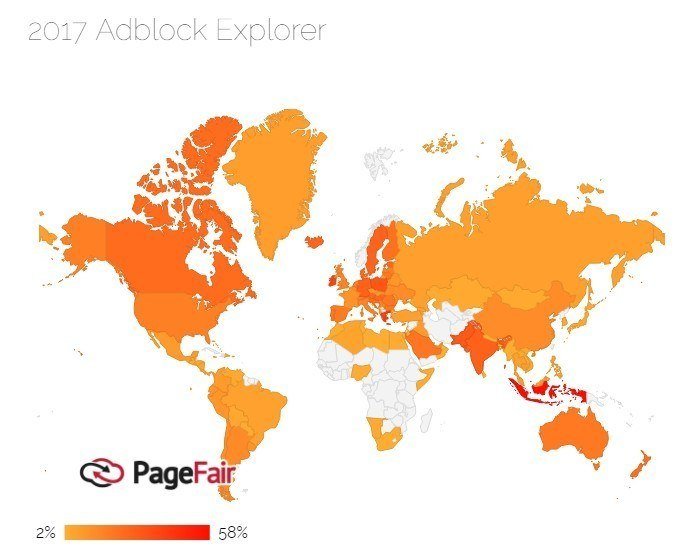Do Blocked Ads Matter for Impressions?
For users, that means they get an ad-free experience when they browse the Internet. But for marketers, that means the potential to lose money, leads, and valuable time.
That’s because blocked ads do count toward pay-per-click (PPC) and pay-per-view (PPV) totals — at least as far as data shows us.
If you’d like to speak with a specialist before reading on, you can reach us at 888-601-5359.
Get your digital advertising tips straight from the experts.
Read the Blog Post & Watch the Video

The implications of blocked ads
At first glance, ad blockers don’t seem like that big of a problem. They just make the Internet look a little cleaner for people who don’t want to see your ads. And if people don’t want to see your ads, they probably wouldn’t click on it anyway. So basically, you’re refining and targeting your audience even more than you were before.
Unfortunately, there’s more to ad blockers than that.
While they may weed out wasted impressions, many advertising outlets still count blocked ads toward your total impressions. So if you pay by the impression or view, you’re suddenly paying much more than you originally intended. And even if you pay by the click, your conversion rate will still be skewed low.
Yes, you may get 1 million impressions on a campaign — but how many of those people actually saw it? That’s what many advertisers today struggle to find out.
Why do people use ad blockers?
People use ad blockers so they don’t have to be distracted or waste time with unwanted ads. Currently, 615 million devices currently use adblock.
With about 3.2 billion people using the Internet worldwide, that means a full, about 11% of Internet users are actively blocking advertisements.

Some ad blockers are so sophisticated that they can stop ads from some of the biggest ad providers in the world, including Facebook, YouTube, and even Google AdWords. So if you apply that to your company’s online ad campaigns, you’ve lost 11% of your potential audience (assuming all other factors are equal).
That means you could be overpaying on your impression- or view-based ads by up to 11%.
That may not seem like much for an individual campaign — but those campaigns add up over time. If you repeat the same ad campaign 10 times, that means you’ve spent enough money for 10 ad campaigns, but you’re only getting the results of nine.
That’s a huge problem. Fortunately, some advertising outlets have started innovating.
How advertisers have changed in response to ad blockers
Google is constantly at the forefront of advertising, especially PPC and display advertising.
So it’s no surprise that Google has taken the first step to neutralizing the problems that ad blockers present — the Google Display Network no longer charges by impressions.
Google AdWords is also safe in this regard since it only charges per click, not per impression. In fact, all PPC providers should be okay since they’ll still record users with ad blockers as an impression, but won’t actually charge you anything for the missed click.
The only downside is that your conversion rate will be skewed lower than it would be in a world without ad blockers.
The real question is: Will other ad providers and social media outlets follow Google’s lead? Or will they continue to charge by impressions?
After all, advertising providers are still making money off of this as if nothing’s happened. It’s their users — you and your marketing team — who are paying for nothing. So that’s the big question that’s on advertisers’ minds. You shouldn’t have to pay for ads that are served, but not displayed. So for every person that’s using an ad blocker, they’re costing advertisers valuable dollars.
At the time of publication, this issue hasn’t escalated very far. But the potential for blocked ads, misrepresented impressions, and lost revenue is huge.
Over time, it’s likely that other advertising platforms like Facebook and Twitter will start to charge by metrics besides impressions as well.
Or at least they should. Their prime customers — advertisers — are constantly losing money to ad blockers. The best way to fix that is to stop charging advertisers by the impression and switch to clicks instead.
The good news
Believe it or not, there’s some good news about ad blockers.
First of all, there’s no universal ad blocker that crosses from mobile to desktop and back.
In addition, mobile ad blockers don’t apply to apps. So you can still get results from app-based display ads.
Third, ad blockers still aren’t that popular with all Internet users. Yes, 11% of Internet users actually have ad blockers installed, but that whole percentage isn’t likely to be your entire target audience.
WebFX is a full-service Internet marketing agency
At WebFX, we understand ad blockers and the threats they pose to advertisers like you.
That’s why we offer services in a variety of fields, including PPC, SEO, content marketing, social media marketing, and more. Even with 11% of Internet users installing ad blockers on their computers, we still get results for our clients and we’ll do the same for you!
Contact us today to start working on your next marketing campaign!
Marketing Tips for Niche Industries
- 8 Tips to Propel PPC for Cleaning Services
- A Look at WebFX’s Top-Notch PPC for Plastic Surgeons
- Accelerate Your ROI with WebFX’s PPC for Urgent Care Centers Services
- Dermatology PPC: How to Attract More Patients with Dermatology Ads
- Ecommerce PPC: Everything You Need to Know
- Effective PPC for Credit Unions
- Franchise PPC: Services & Tips for Success
- Garage Door Advertising & PPC Management
- Getting Started with PPC for Lawyers
- Outstanding PPC for Contractors







